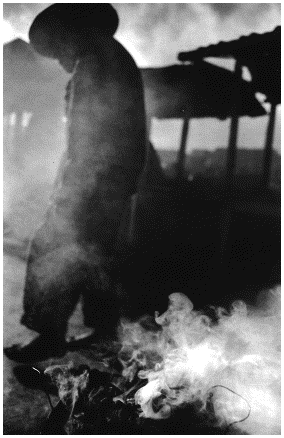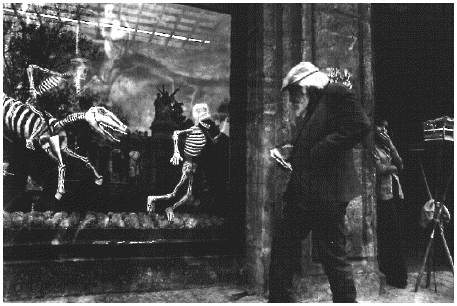Ice-Cream
Man
 In The Works of Love, the old man hires himself out every December to be Santa Claus. The rest of the year, he wanders around town, or stays in the park, or sleeps on a bench in the bus station. He writes postcards to his son who he hasn't seen for fifteen years.
In The Works of Love, the old man hires himself out every December to be Santa Claus. The rest of the year, he wanders around town, or stays in the park, or sleeps on a bench in the bus station. He writes postcards to his son who he hasn't seen for fifteen years.
He writes,
Saw robin in park today. Saw him catch worm. Am thinking of sending you to college. Am thinking of sending you to Yale, to Harvard.
He carries the postcard around in his pocket for months at a time, until it gets worn and bent. He always writes in pencil, and every few days, he erases one of the words, changes it for another. He changes "robin" to "bluebird," changes "Yale" to "Princeton." He never does send the card.
I see the old man on the streets of Puerto Perdido almost every day. But instead of being Santa Claus, he's the ice-cream man. He pushes a heavy blue wooden wheelbarrow up and down the streets all day long. He is always dressed in white, with worn huaraches on his feet.
Hung on the side of the wheelbarrow is a plastic bag filled with cones. When you ask for an ice cream, he stops, puts down the wheelbarrow, opens the top of the round wooden tub, scoops out some of the watery ice cream with a metal spoon, and gives it to you --- the tiny cone engulfed in his gnarled, dark hands.
The wheelbarrow is a homemade one, and I like to think that he built it himself, many years ago, exactly to his specifications. After so many years, it has become an extension of him, like an arm or a leg. The handles are exactly at the height of his wrists. When he picks it up, his stooped shoulders draw down a little, his back rounds a bit more, and he starts trudging down the street with his great Oaxacan feet --- those big, hoary, rooted feet, much like the roots of the tree they call the tule that lie exposed after a storm has passed.
I like to think, because of the years of marriage between man and cart that --- at night --- when he goes to his tiny shack over in the valley to eat the simple supper that one of the neighbor ladies makes for him (beans, tortillas, rice), and when he finally lies down to rest, he is still somehow connected to his blue cart --- perhaps even has dreams of pushing a dream electric-blue ice-cream cart, light as a feather, through the streets of some bright paradise.
After you give him his peso, he drops it in his pocket, and then lets his hands down, and they pick up the cart, and he plods on. I often catch myself wondering how someone as ancient as him can make it up and down those steep hills near the bay ---- for I have seen him in all the many parts of town: in the old part of the city up the hill, in the tourist area that runs next to the beaches, and, sometimes, pushing himself and his load across the hot beach.
I wish I could say that he was merry or sad --- but, in truth, his face is expressionless: I've never seen him smile, I've never seen him frown. As soon as I say that, I have to amend it because the lines in his face run so deep that you don't expect a frown or a smile. Indeed, the lines run so deep that you wonder how he ever shaves in the morning. Maybe it's better to say that his face is so rich with history that it can't be said to be "expressionless." It is, rather, a illuminated manuscript, filled with sad and wise and maybe even funny tales out of his youth.
When I see him I sometimes think of that poem of Yeats --- the one in which the poet takes the parents of a newborn child far into the future so they can look in on their boy as he nears the end of his life. The poet lets them know that at the moment of their son's birth they have also created another ancient man, who, in some far off time, will be stooped and bent, shuffling slowly to the end of his days.
It is the eyebrows most of all that give my old ice cream man his character. They have taken on the wildness of the white bouganvilla that grow in such profusion everywhere in Puerto Perdido, plants towering up like clouds. His white eyebrows are like that --- growing every whichaway, in wild disorder.
 He's been missing recently, but then I saw him again yesterday in the public market. The last of his strength must be ebbing away. He was trudging along as before, but more slowly, and, instead of the heavy wheelbarrow, he now carries a modest white plastic cooler, hung over his shoulder with a homemade knitted strap. Someone has scratched Helados on the four sides of it.
He's been missing recently, but then I saw him again yesterday in the public market. The last of his strength must be ebbing away. He was trudging along as before, but more slowly, and, instead of the heavy wheelbarrow, he now carries a modest white plastic cooler, hung over his shoulder with a homemade knitted strap. Someone has scratched Helados on the four sides of it.
He marches, undeviating, as if he were still shouldering the great wheelbarrow. His eyebrows still are an explosion of white; his face is still an ancient, beautiful, illuminated book. And in his back pocket is the card that he's been meaning to send to his son, the child he hasn't seen for so many years.
The photographs are from
Chiapas --- The End of Silence
by Antonio Turock (Aperture)
* * *